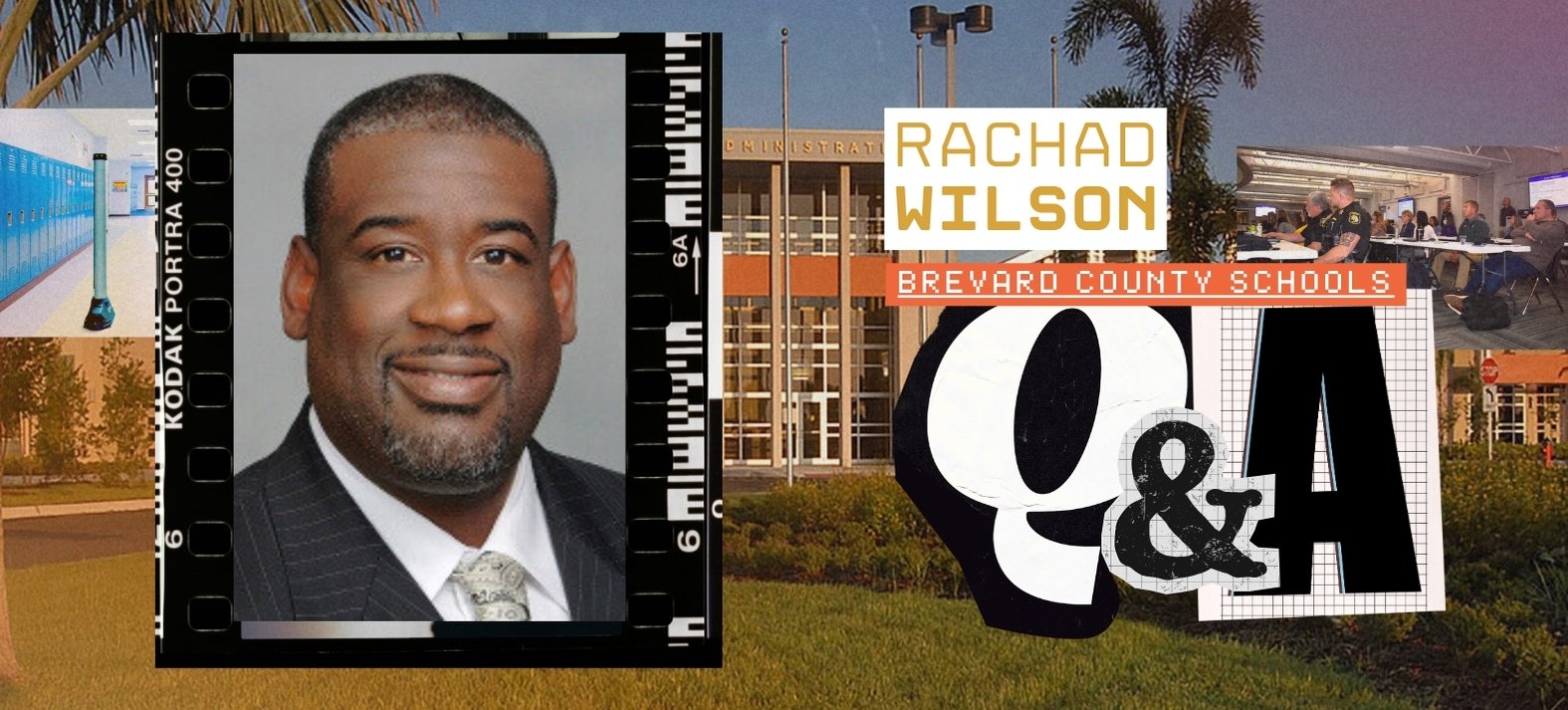Rachad Wilson’s path to becoming Chief Operating Officer at Brevard County Schools had a few twists and turns, but it always followed a steady road built on relationships, service, and a deep commitment to giving back.
Growing up in a service-oriented household, Wilson always knew he wanted to make a difference. After graduating from Rockledge High School in 1993, he attended Northeast Mississippi Junior College, where he played football and earned his AA degree. He then transferred on scholarship to the University of South Carolina, continuing his football career.
After graduation, he found his calling in education, teaching and coaching at Eau Claire High School, a Title I school in Columbia, South Carolina. Two years later, he returned home to Brevard County to teach at Endeavour Elementary before transferring to Merritt Island High School, where he continued teaching and coaching football.
After four years at the high school level, Wilson’s principal saw his leadership potential. “He asked me, ‘Have you ever thought about being an administrator?’” Wilson recalled. His response at the time was, “Nah, I want to coach football.” But eventually, he was ready for something different. Wilson earned a master’s degree in educational leadership and became an assistant principal in 2007.
It was a natural fit. “I was never a follower. I always considered myself a leader,” he said. Just a few years later, he was named Assistant Principal of the Year, which led to a principalship at the same elementary school where he had first taught. Over the years, Wilson served as assistant principal at Cocoa High School, principal at Endeavour Elementary, and principal at Cocoa Junior-Senior High School, all within the same tight-knit Cocoa community, building trust along the way.
“Relationships are the epicenter of everything I do,” Wilson said. “What better career is there where one can authentically give back than being an educator and working with kids day in and day out?”
The K12 Facilities Forum sat down with Wilson to understand how his district of more than 74,000 students is tackling the multiple challenges of ensuring both safe and welcoming spaces for students and staff alike, as well as what security-focused tech he sees on the horizon.
Looking ahead to the next 3–5 years, what emerging technologies or approaches do you see as most promising for enhancing school safety—including AI—and what challenges do you anticipate in implementing them?
Wilson: AI is at the forefront of everyone’s mind right now. At the district level, we’re still exploring its potential, but to be honest, cost is the biggest roadblock.
That said, we’ve made significant progress with other technologies. Our schools now have hardened access control. Every front office requires a buzz-in system, clerks are trained to vet visitors before entry, and once inside, staff are protected behind an enclosed space. We believe in layers of protection.
We’re in our second year of using OpenGate weapons detection systems at our high schools, and they’ve proven effective—we’ve already intercepted a firearm and several other prohibited items. For behavioral and wellness, we use Florida’s Harm and Prevention and Threat Management Model, which ensures every threat is logged, reviewed by a school team, and monitored at the district and state level. Beyond cost, another challenge includes privacy concerns for families and staff across the district.
Training is key. We focus on integration and making sure teams know how to use tools effectively. The same goes for reunification and emergency drills: we practice until the response becomes second nature. Our goal is always to be proactive, not reactive.
What does a comprehensive approach to school security look like in Brevard County? How do you balance physical security with maintaining a welcoming learning environment?
Wilson: Our approach is multi-layered and proactive, combining physical safety with mental health. On the physical side, we use surveillance systems, visitor management, and emergency communication tools designed for rapid response.
Training is equally important. Staff, students, and law enforcement partners practice regular drills and follow crisis response plans. Brevard also benefits from a unique partnership: our sheriff’s department runs the district’s security office. Our county Sheriff takes school safety seriously, and his team works closely with our schools in that effort.
The challenge is balancing effective security with a welcoming school culture. We use fencing and access controls, but we avoid intimidating measures like bars on windows. Instead, we’re exploring upgrades like bullet-resistant windows and attack-resistant film—layers of security that don’t compromise a school’s environment.
Our school resource officers are highly visible and equipped to respond quickly, serving as both a deterrent and a reassurance for students and staff.
Walk us through your district’s handling of threat assessments and prevention. How do you train staff and students to identify issues before they escalate?
Wilson: Our model is proactive and team-based. Each school has a multidisciplinary threat assessment team that includes administrators, counselors, mental health staff, and law enforcement. These teams use standardized protocols, including youth mental health training, to evaluate concerns, assess risk, and design interventions.
It’s not just about assessing threats; it’s about connecting students with resources. Whether that means counseling, behavioral support, or family engagement, we aim to resolve challenges constructively.
Training plays a huge role. Teachers, staff, and support personnel are trained to recognize warning signs, changes in behavior, distress signals, or concerning online patterns. Ongoing professional development helps ensure concerns are reported and addressed appropriately.
Students are often the first to see or hear something, so we make reporting safe and accessible through anonymous tip lines, hotlines, and digital platforms. That peer-to-adult communication has prevented incidents more than once.
Mental health and school safety are increasingly recognized as interconnected. How does Brevard County integrate mental health resources into its security strategy?
Wilson: Mental health is central to our security framework. We’ve expanded access to mental health services significantly. Every school has a counselor or social worker assigned 1–3 days per week, with contracted services filling in where needed.
Staff are trained to recognize early warning signs so interventions can happen before problems escalate. Student and family engagement is critical; we emphasize open communication to de-stigmatize mental health issues. When families feel comfortable reaching out and students feel safe asking for help, we can resolve issues more effectively.
It’s a proactive approach: consistent communication, strong partnerships, and early intervention. The reality is that this is a widespread challenge, but by combining trained staff, accessible services, and open dialogue, we’re making mental health support a visible strength, not a weakness.
How has your district adapted its security protocols in response to evolving threats, and what lessons have been most valuable in shaping your current approach?
Wilson: Security must be multi-layered, adaptable, and people-centered. Technology and physical measures are important, but strong relationships are what make the greatest difference. Safety isn’t just the principal’s job or the SRO’s job; it’s everybody’s responsibility.
We continually update protocols based on national best practices and our own experiences. Prevention and intervention strategies are layered, and training keeps everyone aligned with the latest procedures.
Finally, community engagement is essential. We’re transparent with families and the broader community about what we’re doing and why. That clarity builds trust and reinforces the idea that school safety is a shared responsibility.
Posted by
Join us at the K12 Facilities Forum!
The community for district and facilities leaders
Nov 8-10, 2026 | San Antonio, TX








-3.png)

Comments